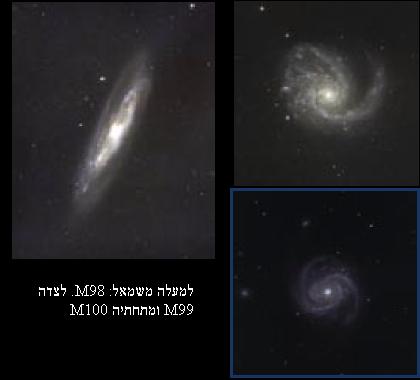The group of galaxies Sheroth Wernicke (Sheroth Shulamit) is now entering the center of the sky and contains many galaxies.
Tammy Plotner and Jeff Barber, Universe Today

The group of galaxies Sheroth Wernicke (Sheroth Shulamit) is now entering the center of the sky and contains many galaxies. You should start with the star Danbola (Beta Leonis - the second brightest star in the Leo group) and move east 6.5 degrees to the star 6 Coma Berenices. After focusing on 6 COMAE, move back towards Denobella about half a degree to view one of the faintest of the Messier galaxies - M98 - a luminosity 10 spiral galaxy seen almost from the side. It was discovered together with M99 and M100 by Pierre Machin on March 15, 1781. The three became the last three galaxies in Messier's list, as published in the third edition of the catalog.
While M98 will be a little disappointing to viewers in small telescopes, it is a feast for the eyes as an example of a spiral galaxy lying on its side, in large telescopes.
It is worth focusing again on 6 Comae and moving less than one degree to the southeast - the next study - the spiral galaxy M99, which has a brightness of 9.8. If we instead go the same distance to the east, we will encounter the galaxy of magnitude 11.2 - NGC 4262 and the same action towards the south will bring us to NGC 4212 of magnitude 11.5 and its neighbor of magnitude 13 - IC 3061. It was Lord Ross, after observing the galaxy M99 who recognized the spiral nature of Some of the galaxies in the spring of 1846.
In the galaxy M100 – the last one in Monsieur's original list, it can be observed if we focus again on 6 Comae. At low intensity moved 2 degrees towards the northeast. M100, which has a brightness of 9.4 appears not brighter than M99 because of its larger apparent size. Like M99, M100 was also on Lord Ross' list of spiral galaxies, which included 14 spiral nebulae (in the 19s, they did not know that these were galaxies, because they believed that there was only one galaxy in the universe - the Milky Way).
M100 has two large asymmetric arms, which can be seen through a large telescope. On this occasion, you should also observe the galaxy NGC 4312 which is south of M100 (magnitude 11.8) and IC 783 (magnitude 13) which is a similar distance west of M100.
Universe Today website
